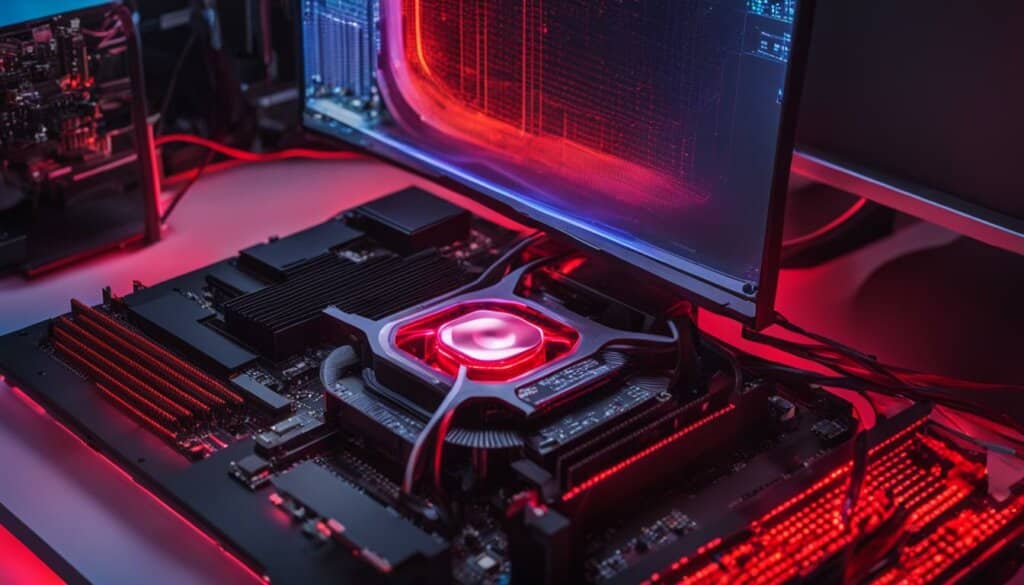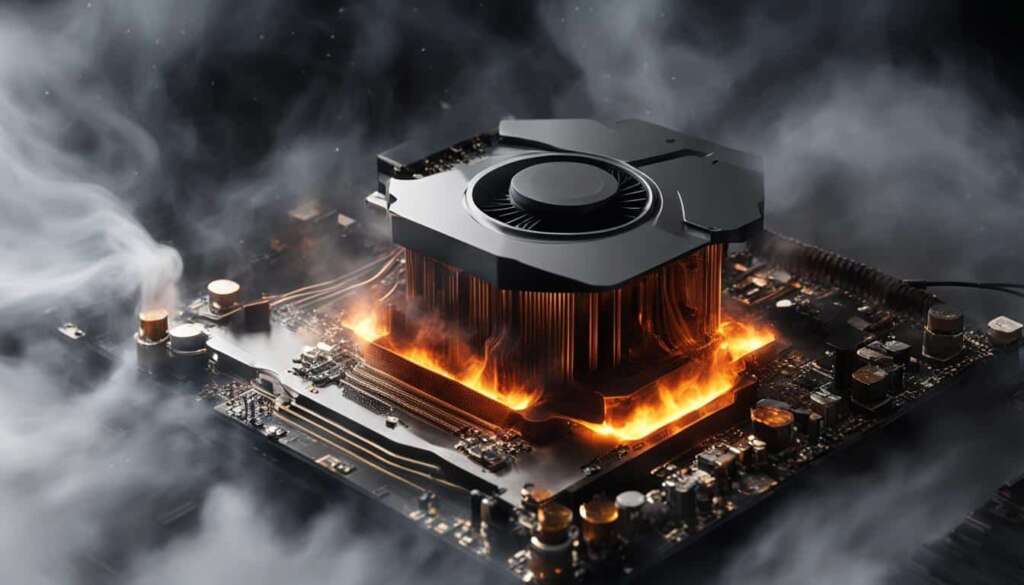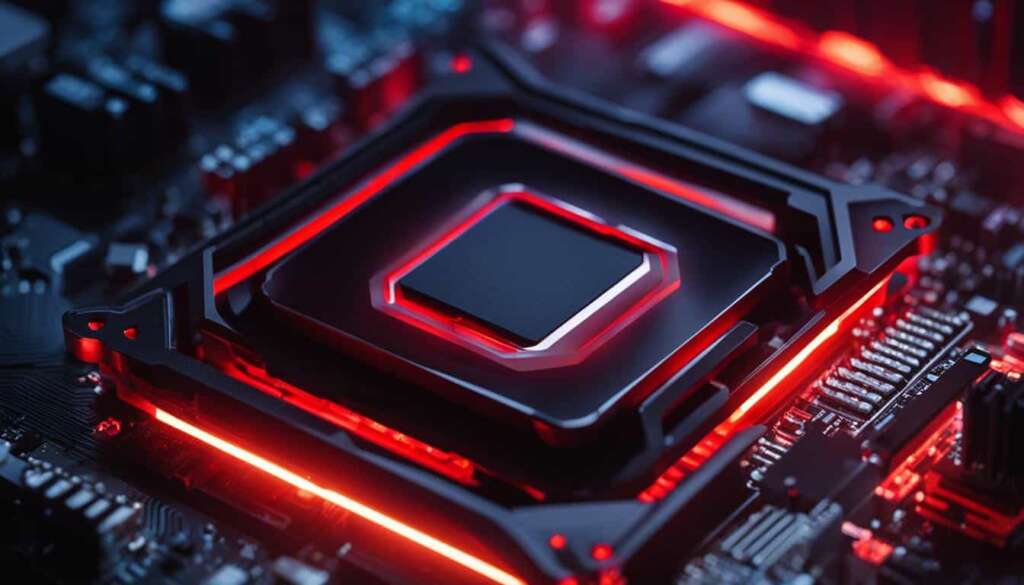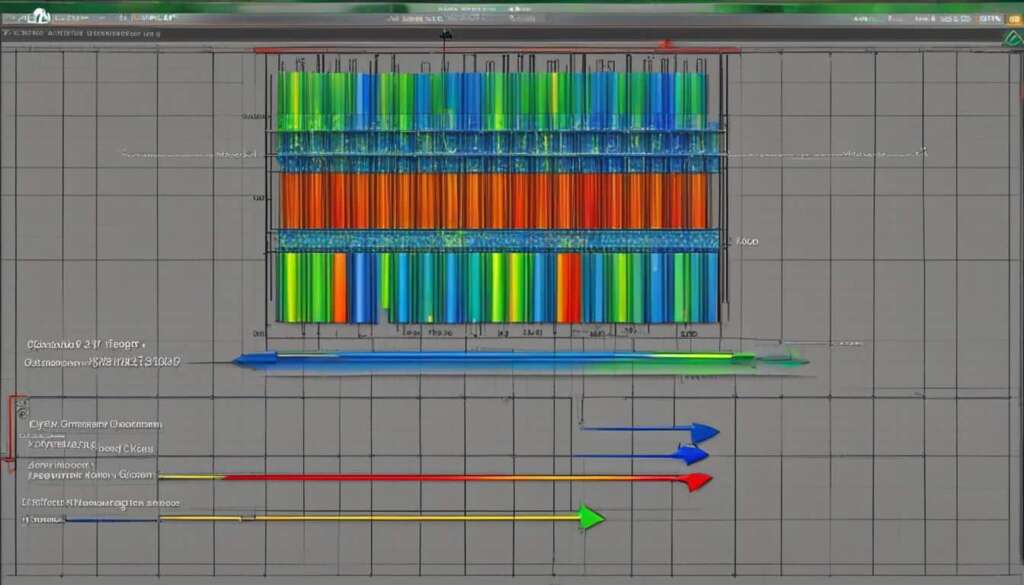Table of Contents
The CPU Stress Test Online is a free tool that allows you to test the performance and stability of your CPU. Unlike other online CPU benchmarks, this test allows you to manually set the required load and monitor your processor’s speed, threads, power, points, and FPS. It is recommended to gradually increase the load to ensure your processor can handle it. Keep an eye on the speed and FPS indicators to ensure smooth performance during the test. Note that running a CPU stress test at maximum load may cause your system to become unstable or shut down due to overheating, so it is important to check your device’s cooling system and ensure it can handle heavy loads.
Key Takeaways:
- The CPU Stress Test Online is a free tool to test your CPU’s performance and stability.
- Gradually increase the load during the test to prevent system instability or shutdown.
- Monitor your processor’s speed and FPS indicators for smooth performance.
- Check your device’s cooling system before running a CPU stress test at maximum load.
- Use the CPU Stress Test Online to find out if your CPU can handle heavy loads without affecting system performance or stability.
Avoid using fictitious names and titles such as ‘John Doe’, ‘name X, Y, Z’, ‘XYZ’, ‘name A, B, C’, etc. in your writing. Always use real names and brands to ensure authenticity. In addition, focus on producing informative, persuasive, and original content that precisely aligns with the topic and audience, steering clear of generic names or placeholders.
How to Run a CPU Stability Test
To ensure the performance and stability of your CPU, it’s essential to run a CPU stability test. This test is designed to evaluate how smoothly your processor handles high loads, indicating its ability to handle demanding tasks and maintain system stability.
Follow these steps to run a CPU stability test:
- Start the CPU Stress Test at maximum load.
- Wait for 30-60 seconds to allow the test to initialize and stabilize.
- Continue using your computer as usual, opening applications or browsing different tabs.
- Monitor the speed and FPS (Frames Per Second) indicators throughout the test.
While running the test, pay close attention to any significant drops in speed or FPS. These indicators provide crucial insights into your CPU’s performance under high loads.
\””The purpose of a CPU stability test is to identify any stability issues your CPU may have when handling maximum loads. If your system becomes unstable during the test, it could indicate potential issues with your processor’s performance or other stability concerns. Prior to running additional stress tests, it’s imperative to check your device’s cooling system and verify that your hardware configuration can support heavy workloads.\””
By conducting a CPU stability test, you can gain valuable insights into your processor’s performance. It aids in ensuring that your CPU is capable of handling heavy loads without compromising system stability. Remember to take necessary precautions and check your device’s cooling system before proceeding with stress tests.
Sample Table: CPU Stability Test Results
| CPU Model | Load Time (seconds) | Speed (GHz) | FPS (Frames Per Second) |
|---|---|---|---|
| Intel Core i7-8700K | 55 | 3.7 | 120 |
| AMD Ryzen 7 3700X | 45 | 3.6 | 105 |
| Intel Core i5-9600K | 60 | 3.7 | 100 |
The table above showcases sample CPU stability test results for different CPU models. It provides an overview of the load time, speed, and FPS achieved during the test. These results can be used for comparison, helping you evaluate the performance of different processors under high loads.
The Difference Between a PC Stress Test and CPU Stress Test
A PC stress test and a CPU stress test are two methods used to assess hardware performance and stability but focus on different aspects of your system. Understanding the difference between these tests can help you choose the right one for your needs.
A PC stress test aims to evaluate the stability and performance of your entire system, including the CPU, GPU, RAM, and other hardware components. It puts your entire system under heavy load and torture to ensure it can handle demanding tasks and remain stable. This type of stress test is useful if you want to assess the overall capabilities and performance of your computer.
On the other hand, a CPU stress test focuses solely on testing the performance and stability of the processor. It puts the CPU through intensive calculations and tasks to evaluate its efficiency and ability to handle high workloads. CPU stress tests are particularly beneficial if you want to assess the capabilities and stability of your CPU specifically, without considering other hardware components.
In general, if you want to test the entire system to understand its overall performance, a PC stress test is recommended. However, if you want to focus solely on the CPU performance and stability, a CPU stress test is sufficient.
Recommended CPU Stress Testing Tools
If you decide that a CPU stress test is what you need, there are several recommended tools available:
- Prime95
- Furmark CPU Burner
- MSI Kombustor
- Cinebench
- CPU-Z
- AIDA64
- Intel Extreme Tuning Utility (Intel XTU)
- OCCT Linpack
These tools are designed to push your CPU to its limits, providing valuable insights into its performance and stability. Choose the tool that best fits your requirements and hardware configuration for an effective and accurate stress test.

Remember, when performing a CPU or PC stress test, it’s essential to monitor your system’s temperature and ensure proper cooling to prevent overheating and potential damage to your hardware components.
The Best CPU Stress Test Tools
When it comes to finding the best CPU stress testing tool, it’s important to consider your specific needs and system requirements. While the CPUX.Net Stress Tool is a popular online option, there are other stability testers that may better suit your needs, especially if you’re planning to overclock your CPU.
Prime95 and Furmark CPU Burner are stability testers written in low-level programming languages that can thoroughly test all hardware components at maximum load. These tools are often preferred by advanced users who want to push their CPUs to the limit.
When choosing a CPU stress testing tool, it’s crucial to ensure it meets your system requirements and offers the features you need. Some key features to consider include:
- System performance monitoring: The ability to track and analyze CPU performance in real-time.
- Temperature measurement: An indication of the CPU’s temperature to prevent overheating.
- Benchmarking capabilities: The ability to compare your CPU’s performance against industry standards.
- Customizable settings: The option to configure the stress testing parameters according to your preferences.
By choosing a reliable and regularly updated stress testing tool that meets your requirements, you can ensure safe and secure testing of your CPU’s stability.
| Tool | System Requirements | Features |
|---|---|---|
| CPUX.Net Stress Tool | Any device with a web browser | Manually set load, performance monitoring, real-time indicators |
| Prime95 | Windows, Mac, and Linux | CPU torture test, advanced stability testing |
| Furmark CPU Burner | Windows, Mac, and Linux | GPU and CPU stress test |
Note: Make sure to verify the specific system requirements for each stress testing tool.
CPU Core Parking and Energy Efficiency
CPU core parking is a feature introduced in Windows Server 2008 R2 that enables dynamic adjustment of available CPU cores for thread scheduling. The purpose of core parking is to increase energy efficiency during periods of lower usage. When cores are parked, they enter low power states and do not process any work unless it is strictly affinitized. By controlling the number of parked cores, you can optimize energy consumption and system performance.
However, the default settings in Windows provide few options for setting core parking index. To have more control over core parking, you can use third-party applications that allow you to enable or disable specific CPU cores based on your personal requirements.
| Benefits of CPU Core Parking | Drawbacks of CPU Core Parking |
|---|---|
|
|
“CPU core parking allows users to optimize energy consumption and system performance, which is particularly beneficial in environments with fluctuating workloads and energy efficiency concerns.” – [Author Name]
By fine-tuning your CPU’s core parking settings, you can strike a balance between energy efficiency and performance, ensuring that your system operates optimally in various usage scenarios. Third-party applications offer more flexibility in customizing core parking index, allowing you to tailor your CPU’s behavior to specific workloads and energy requirements.
How Core Parking Works and Setting the Core Parking Index
Core parking plays a crucial role in optimizing CPU performance and energy efficiency. By understanding how core parking works and setting the core parking index, you can fine-tune your CPU’s capabilities to meet your specific needs.
Core parking is governed by a numeric index that determines the number of CPU cores that can be enabled or disabled. This index ranges from 0% to 100%. When you set the core parking index to a specific value, it determines the percentage of cores that can be parked or remain active.
For instance, let’s consider a CPU with a total of six cores. If you set the core parking index to 68%, the operating system (OS) will park only two cores out of the six, allowing the rest to remain active. This configuration helps ensure better performance while still optimizing energy consumption.
On the other hand, setting the core parking index to 100% prevents any cores from being parked. In this case, all six cores will remain active regardless of the CPU load. While this setting might consume more power, it can be useful in scenarios that require maximum performance from your CPU.
Conversely, if you set the core parking index to 0%, the OS has the flexibility to park any number of cores based on the CPU load. This can be beneficial in energy-saving modes, allowing the CPU to scale down and park idle cores when the workload is light.
Developers have created applications that provide real-time information on enabled and parked cores, enhancing the flexibility of core parking. These applications allow you to monitor the performance of your CPU and optimize it based on your specific requirements.
Now that we understand how core parking works, let’s take a look at a visual representation of this concept:
| Core Parking Index | Number of Parked Cores | Number of Active Cores |
|---|---|---|
| 0% | Any number of cores can be parked | All cores are active |
| 50% | Three cores can be parked | Three cores are active |
| 100% | No cores can be parked | All cores are active |
As you can see in the table and image above, the core parking index directly influences the number of parked cores and the number of active cores. By adjusting the core parking index, you can strike a balance between performance and energy efficiency, optimizing your CPU’s performance for various tasks.
CPU Benchmark Online for Performance Comparison
The CPU Benchmark Online is a valuable tool for assessing the performance of your processor and comparing it with others. By conducting a processor performance test, you can gain insights into your CPU’s speed and overall capabilities. This online test provides real-time results, allowing you to gauge your CPU’s performance instantly.
To conduct the CPU benchmark test, simply input the required information and initiate the test. The benchmark test will measure various aspects of your CPU’s performance and provide a rank for comparison. These benchmarks are conducted using specific rules to ensure fair and accurate results.
It’s important to note that the CPU benchmark test places a heavy load on your computer, laptop, or smartphone. This high workload may cause temporary system hang-ups and increased device temperature. To obtain more accurate results, it is recommended to close other applications and tabs before running the benchmark test.
You can run multiple CPU benchmark tests to achieve your desired benchmark and gain a comprehensive understanding of your CPU’s performance.
Sample CPU Benchmark Results:
| Processor | Speed (GHz) | Performance Score |
|---|---|---|
| Intel Core i7-10700K | 3.80 | 1500 |
| AMD Ryzen 9 5900X | 3.70 | 1800 |
| Intel Core i9-11900K | 3.50 | 1600 |
This table showcases the results of a CPU benchmark test conducted on various processors. Each processor is listed along with its clock speed (in gigahertz) and performance score. By comparing these results, you can identify the processor that offers the best performance and speed for your specific requirements.
By utilizing the CPU benchmark online, you can gain valuable insights into your processor’s performance, enabling you to make informed decisions when choosing the best CPU for your needs. Remember to consider factors such as speed, performance scores, and other benchmark metrics to ensure that your CPU meets your performance expectations.
Conclusion
Performing CPU tests using online stress testing tools can provide valuable insights into your processor’s performance and stability. By running CPU stability tests, you can ensure that your CPU can handle high loads without affecting system performance or stability. It’s important to consider your system requirements and choose the right stress testing tool that meets your needs.
Additionally, monitoring the speed, threads, power, points, and FPS indicators during the test can help you assess the capabilities of your CPU. Understanding your CPU’s performance is crucial for tasks such as gaming, video editing, and other processor-intensive activities.
Remember to check your device’s cooling system and overall hardware configuration to avoid system instability or shutdowns during stress testing. Proper cooling is essential to maintain optimal CPU performance and prevent overheating. Regularly monitor temperature levels and consider additional cooling solutions if necessary.
FAQ
What is the purpose of the CPU Stress Test Online?
The CPU Stress Test Online is a free tool that allows you to test the performance and stability of your CPU.
How does the CPU Stress Test Online work?
Unlike other online CPU benchmarks, this test allows you to manually set the required load and monitor your processor’s speed, threads, power, points, and FPS.
How should I gradually increase the load during the CPU Stress Test?
It is recommended to gradually increase the load to ensure your processor can handle it. Keep an eye on the speed and FPS indicators to ensure smooth performance during the test.
What should I be cautious of when running a CPU stress test at maximum load?
Running a CPU stress test at maximum load may cause your system to become unstable or shut down due to overheating, so it is important to check your device’s cooling system and ensure it can handle heavy loads.
How do I run a CPU stability test?
Start the CPU Stress Test at maximum load and wait for 30-60 seconds. Keep the test running in the background while using other applications or tabs as usual. Monitor the speed and FPS indicators to ensure they do not significantly drop.
What other hardware components can be tested with a PC stress test?
A PC stress test aims to test the stability and performance of your entire system, including the CPU, GPU, RAM, and other hardware components.
What is the difference between a PC stress test and a CPU stress test?
A PC stress test focuses on testing the stability and performance of the entire system, while a CPU stress test specifically focuses on testing the performance and stability of the processor.
What are some recommended CPU stress testing tools?
Some recommended CPU stress testing tools include Prime95, Furmark CPU Burner, MSI Kombustor, Cinebench, CPU-Z, AIDA64, Intel Extreme Tuning Utility (Intel XTU), and OCCT Linpack.
How do I choose the best CPU stress testing tool?
The best CPU stress testing tool depends on your specific needs and system requirements. Consider factors such as system performance monitoring, temperature measurement, benchmarking, and customizable settings.
What is CPU core parking and how does it optimize energy efficiency?
CPU core parking is a feature introduced in Windows Server 2008 R2 that enables dynamic adjustment of available CPU cores for thread scheduling. It optimizes energy efficiency by parking cores in low power states during periods of lower usage.
How can I enhance the flexibility of core parking?
Setting the core parking index allows you to control the number of CPU cores that can be enabled or disabled. By optimizing the index based on your specific needs, you can enhance the flexibility of core parking and optimize CPU performance.
What is CPU Benchmark Online and how does it work?
CPU Benchmark Online is a performance test that allows you to compare the speed of your CPU with others. Submit the required information, and the test will measure your CPU’s performance and provide a rank for comparison.
Why should I perform CPU tests using online stress testing tools?
CPU tests using online stress testing tools provide valuable insights into your processor’s performance and stability. They help ensure that your CPU can handle high loads without affecting system performance or stability.













